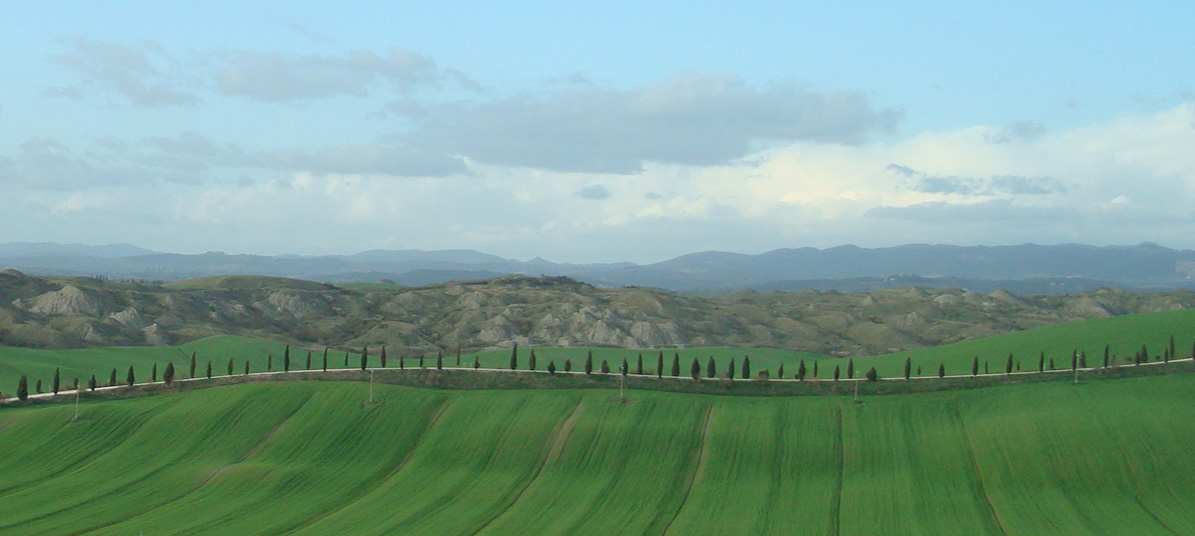| |

|
 |

|
 
 |
|
Southern Tuscany is an undiscovered jewel, the area provides both a cultural feast and a natural one. The world off the beaten track, where wooded hills, valleys, rivers, and lakes frame a unique historical and archeological paradise. From the Etruscans to the Romans and from the Middle Ages through the Renaissance to our present times, history of mankind has left, layer after layer, its trace in an incredible succession. It is difficult to find elsewhere so many memories of different eras all together and in such a special setting. From the stunning coastal paths of the Cinque Terre to the mountain lakes of the Dolomites and the artistic treasures of Tuscany, follow ancient paths through vineyards, olive groves, and colourful villages and discover the timeless beauty of Italy.
The territory of the Val d’Orcia is mainly covered with gently rolling hills. The river Orcia springs from a gorge and winds its way across the valley. The Val d’Orcia has a long geographical history: it’s 5 million years old. The two volcanoes of Southern Tuscany, Radicofani and Monte Amiata, are partly responsible for its appearance: they covered the surface with lava, which then became a type of rock known as trachyte.
Erosion processes played a major role in the formation of the landscape with the clay soil laid bare and forming craggy badlands known as calanchi and clay knolls otherwise called biancane, which can be seen in the areas of Casa a Tuoma (Pienza), Ripalta (San Quirico), Lucciolabella, Beccatello, and Torre Tarugi (Pienza), Contignano, Pietre Bianche and the Poggio Leano (Radicofani).
Northwest of Bagno Vignoni the Val d’Orcia has a less typical landscape, with woodlands and Mediterranean maquis that alternates with the vineyards of Montalcino and then continues towards the sea. On the slopes of Monte Amiata, there are forests of beech and chestnut trees. Other tree species found in the area are the oak and obviously the tree which has become the symbol of the Val d’Orcia: the cypress.
|
|
|
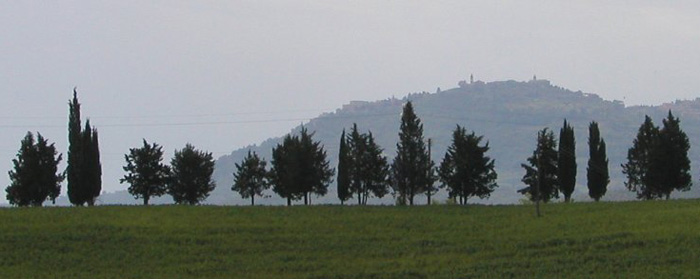 |
|
|
|
|
Montalcino, surroundings
|
| |
|
Art and Culture of the Val d'Orcia
There is an abundance of architectural and artistic treasures in the Val d'Orcia, which makes it a cultural site of universal value. All of the five municipalities of the valley (Castiglione d'Orcia, Montalcino, Pienza, Radicofani and San Quirico) stand out for their urban planning and architecture which dates back to the medieval period (XI-XIV century) and the renaissance (XV-XVI century).
Amongst the most noteworthy works of architectural interest are: the Collegiata church, Palazzo Chigi Zondadari and the Horti Leonini gardens in San Quirico; the cathedral, the church of San Francesco, the “Pieve” or parish church of Corsignano, the Ammannati, Piccolomini and Vescovile palazzi in Pienza; the fortress, the “Palazzo Comunale” or town hall, the church of San Agostino in Montalcino; the Aldobrandeschi fortress in Castiglione; the fortress with its walls built by the Medici, the villa Medici and the church of San Pietro in Radicofani.
Besides these worthy towns of the Val d'Orcia, this territory offers many delightful hamlets, some of which are fortified, and solitary churches and settlements of historical, artistic, architectural and environmental interest which all contribute to a reference network of exceptional value.
The hamlets of Monticchiello, Corsignano, Castelluccio (with nearby the Villa of La Foce and Chiarentana), Spedaletto (grancia or fortified farm once belonging to the hospital of Santa Maria della Scala of Siena), in the territory of Pienza; Rocca d'Orcia (with its imposing fortress Rocca a Tintinnato), Campiglia d'Orcia, Ripa d'Orcia and Vivo in the territory of Castiglione d'Orcia; Bagno Vignoni, Vignoni alto and Ripa d'Orcia in the territory of San Quirico, and the medieval walled hamlet of Contignano in the territory of Radicofani. In the valley, you can also admire many civil and religious buildings dotted throughout the countryside which are tied to the network of farmhouses: San Piero in Campo (a Camaldolite monastery dating back to before 1030 and dominated by the ancient tower Torre Tarugi), Sant'Anna in Camprena and palazzo Massaini. The extraordinary abbey of Sant'Antimo near to the village of Castelnuovo dell'Abate in the territory of Montalcino which dates back to the time of Charlemagne and belonged first to a Benedictine order, then the Guglielmites until 1462, when Pope Pius II put it under the control of the Bishop of Montalcino.
In 2004, UNESCO inscribed the Val d'Orcia as World Heritage site with the following words:
the landscape of Val d'Orcia is part of the agricultural hinterland of Siena, re-drawn and developed when it was integrated in the territory of the city-state in the 14th and 15th centuries to reflect an idealized model of good governance and to create an aesthetically pleasing picture. The landscape's distinctive aesthetics, flat chalk plains out of which rise almost conical hills with fortified settlements on top, inspired many artists. Their images have come to exemplify the beauty of well-managed Renaissance agricultural landscapes.
|
|
|
|
|
|
|
|
|
|
|
|
|
|
Montalcino is a charming walled town set above set in a panoramic
position above olive groves and vineyards which produce the excellent
Brunello wine.
In addition to its sleepy medieval streets and sun-soaked vineyards, Montalcino presents other sights such as the Piazza del Popolo (People's Square) and the Palazzo dei Priori (old Town Hall), as well as the medieval churches of San Francesco, San Egidio and San Agostino. The castle of Montalcino (fortezza) with its two interior courtyards is almost perfectly preserved. The Cathedral (of San Salvatore) and the Diocesano Museum are full of sacred works of art by 11th to 16th century painters, and contain other medieval objects and archeological artifacts from San Antimo Abbey.
Perhaps because of its geographic position, far away from the crowded
main roads and lacking big industrial poles, here a virtually untouched
and to a large extent wild landscape endures. The territory of
Montalcino, symbol of this magical rapport between man and nature, was
declared in 2004, with the four municipalities of Castiglion d’Orcia, Pienza, San Quirico d’Orcia, Radicofani, a UNESCO World Heritage Site.
“The Val d’Orcia is an exceptional reflection of the way the landscape was re-written in Renaissance times to reflect the ideals of good governance and to create an aesthetically pleasing picture. Images of the Val d’Orcia, and particularly depictions of landscapes where people are depicted as living in harmony with nature, have come to be seen as icons of the Renaissance and have profoundly influenced the development of landscape thinking”.
Montalcino has received the Italian Orange Flag award for sustainable tourism.
Because of its strategic position, Montalcino, whose name derives from Mons Ilcinus, “mount of ilexes” in Latin, became a stronghold of the Republic of Siena. Torn between Florence and Siena in the ensuing centuries, in April 1555, after Siena had surrendered to the Medici, more than four-hundred families of Sienese exiles took refuge in the free commune of Montalcino, and under the leadership of marshal Piero Strozzi established the Republic of Siena in Montalcino. In 1559, the treaty of Cateau-Cambrésis stipulated the definitive peace between Spain and France; the little Republic of Montalcino surrendered, and with it the last bulwark of the free communes fell.
|
|
 Montalcino, Piazza del Popolo and the Palazzo dei Priori Montalcino, Piazza del Popolo and the Palazzo dei Priori
|
|
|
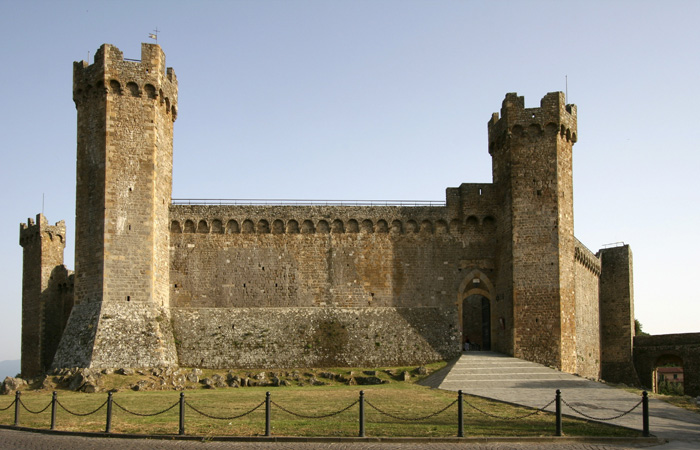 |
|
|
Montalcino, fortress
|
|
|
The Fortress, known as La Rocca, is undoubtedly one of the pillars of Montalcino architecture. It was built in the town’s most accessible spot, facing the Albergheria hill below it and dominating Montalcino with a scenic impact of rare beauty.
The Fortress was built at the behest of the Sienese government, starting in 1361, was reinforced with an external bulwark after Montalcino capitulated in 1559, when the Florentines, to commemorate their conquest, mounted the Medici coat of arms, six balls, on the southwest bastion, where a hanging garden of ilex trees was planted and can still be reached from the courtyard.
|
| |
|
|
|
|
|
|
|
|
|
|
|
|
|
|
|
The Abbey of Sant'Antimo, in a picture-perfect setting, just about 26 km north of Podere Santa Pia, and 10 km south of Montalcino, dates from the 12th century. It's one of the finest Romanesque religious buildings in Italy.
The Abbey is on the Via Francigena and it seems that its founder was Charlemagne. The story goes that, between 774 and 781, he received the relics of St. Sebastian and Sant’Antimo from pope Hadrian and founded in their honour one of the most important monasteries in Tuscany.
Nearby the town of Sant'Angelo in Colle, an enchanting well-preserved village on the top of a hill contained in its circle of walls. From the Abbey of Sant'Antimo, a footpath (6 km) leads to Sant’Angelo in Colle.
|
|
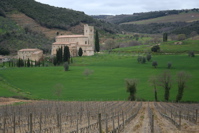
Abbey of Sant'Antimo
|
|
|
Villa a Tolli is an ancient hamlet of Etruscan origin, with an high historical value, architectural and landscape situated in the heart of Brunello. Dating from 1200, it’s on the Roman road leading the north of Tuscany to the Abbey of Sant’Antimo and Montalcino.
The medieval hamlet with main 17th century villa and Italian garden’s style, includes old farmhouses, stables, cellars, old barns and orchards. The small Romanesque church of Santa Lucia, with the ancient apse still preserved is
The name Villa a Tolli, however, dates back to the Etruscan period in which the word “tollee” meant “elevated place” This is where a very ancient settlement from the 4th and 5th Century before Christ has been recovered; just a few meters away from the actual Borgo. The peculiarity of this settlement is the way in which it had been fortified: three great concentric rings of well-preserved walls.
|
|
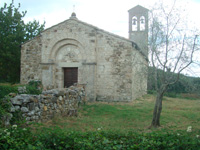
Church of Santa Lucia
|
| Banfi Castle |
|
A medieval castle towering above mountainous forests and lush, rolling vineyards expresses the speechless poetry of Montalcino.
The origin of Banfi Castle can be traced to the ancient Etruscans, but its deepest historical niche was carved during the Middle Ages. The Renaissance Romanesque structure served as the Republic of Siena's first line of defense against attack from the south and, in 1260 A.D., it was awarded to Placido Placidi, hero of the "Battle of Montaperti," which was immortalized by Dante in the "Divine Comedy." The castle's historical name is Poggio alle Mura. Today, Castello Banfi is the crown of a 7,100 acre viti-vinicultural estate.
The castles’s fame derives from its production of one of Italy’s finest red wines known as Brunello di Montalcino.
Brunello, roughly translated as "nice dark one" in the local dialect, is the unofficial name of the clone of Sangiovese (also known as Sangiovese Grosso grown in the Montalcino region. Brunello di Montalcino was Italy's first wine to be accorded D.O.C.G. status. |
|
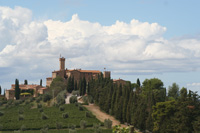
Banfi Castle |
|
|
|
|
|
|
|
|
|
|
|
|
Castelmuzio, is part of the commune Trequanda under the province of Siena. This ancient village dates back to the time of the Etruscans, and is built on a volcanic limestone hilltop overlooking an amazing landscape. Over the years it has been called by several names, Castel Mozzo and later Castello. You can see the old city walls and ramparts, including the embrasures through which cannons were fired. The village includes three churches. The most famous is the Pieve di Santo Stefano in Cennano, just outside the village.
Sant' Anna in Camprena, is an ancient convent between Pienza and Castelmuzio where parts of The English Patient were filmed. The monastery contains remarkable frescoes by Sodoma.
Trequanda stands on the top of a hill, deep in unspoilt countryside of woods, vineyards and olive groves. This former medieval hamlet wasresidence of the Cacciaconti family until the 1500s. A third of the village is taken up by the castle Cacciaconti and its various annexes including a small ornamental garden. The majestic stone tower, partly rebuilt after the war, dominates the entire complex from the north-east and is a singular witness to the original fortified castle structure. From the airy town square where stand the castle, town hall and the splendid romanic church of SS. Pietro and Andrea church of SS. Pietro and Andrea (which contains a fresco by Sodoma), steep and narrow roads and alleys descend where the attentive visitor will be surprised to find ancient covered passages, small votive ceramics, family crests, and beautiful benches in travertine and tufa.
East of Trequanda you reach Sinalunga. Among the most interesting monuments to see in Sinalunga we point out here the Collegiata di San Martino (Saint Martin Collegiate Church), the Chiesa di Santa Croce (Saint Cross Church), the Chiesa di Santa Lucia (Saint Lucy Church), the Pieve di San Pietro ad Mensulas (Saint Peter ad Mensulas Parish), the Chiesa di San Bernardino (Saint Bernardine Church), the Palazzo Pretorio (Praetorian Palace), the Teatro Ciro Pinsuti(Ciro Pinsuti Theatre) and the Antiquarium.
|
|
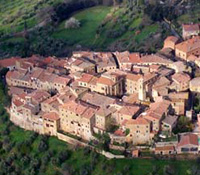
Castelmuzio

Sant’Anna in Camprena,
frescoes by Sodoma
|
|
|
|
|
|
|
|
|
|
|
|
| |
|
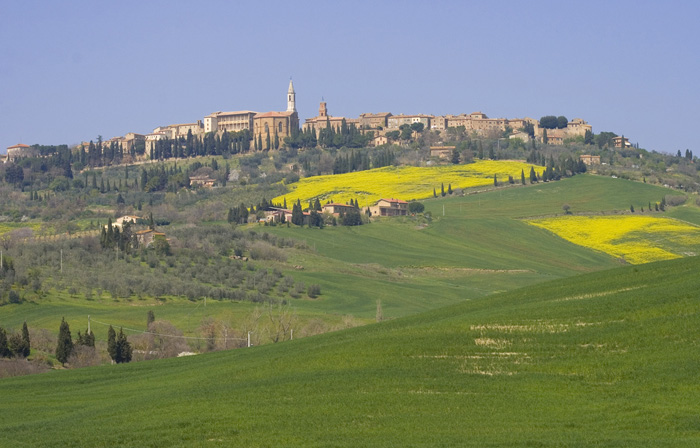 |
| |
|
Pienza
|
|
|
Pienza, situated in the province of Siena, in the Val d'Orcia between the towns of Montepulciano and Montalcino, is the "touchstone of Renaissance urbanism.
Pienza was rebuilt from a village called Corsignano, which was the birthplace of Enea Silvio Piccolomini, a Renaissance humanist who later became Pope Pius II. Once he became Pope, Piccolomini had the entire village rebuilt as an ideal Renaissance town by the Florentine architect Bernardo Gambarelli.
Around Piazza Pio II, the Piccolomini and Borgia palaces and the cathedral are a testimony to this extraordinary vision which has made its historic centre one of the finest in the world.
Outside of the historical center of Pienza, is the Romanesque parish church Pieve di Corsignano, characterized by a cylindric tower and a decorated fortress with mythological and fantastic themes. There are two stunning decorated portals, a cylindrical belfry, and all the sculptures that the stonemasons left on the inside and the outside of the church. Of particular interest is the miniscule crypt under the presbytery.
The Castle of Castello di Spedaletto is situated 9 km from Pienza. This medieval fortress is an important example of a many towered and fortified castle. Inside there is a small church with gothic portal and a nice rose window.
Pienza is known for its pecorino, a fresh sheep cheese.
The pieve di Corsignano is a smaller church in the vicinity and is an important site as the Pope was baptised here.
It has an unusual round tower and a doorway decorated with flower mytholgical motifs. A crib is sculptured on the architrave of the side doorway.
|
|
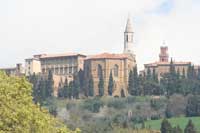
Pienza
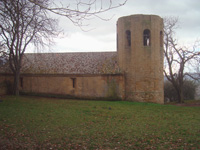
Pieve di Corsignano
|
|
|
San Quiricod'Orcia is a charming, walled town on the northern edge of the Val d'Orcia of southern Tuscany. Located in a strategic position along the Via Cassia (and the old Via Francigena ), San Quirico d'Orcia was often the residence of imperial bailiffs.The more interesting and beautiful building of all San Quirico d' Orcia is without doubt the magnificent Collegiata di San Quirico or Pieve di Osenna. Behind the altar, the magnificent, inlaid panels, by the Siennese Antonio Barili, date from between 1482 and 1502. On the left side of the third arcade it's the tombs of Count Enrich of Nassau, who died in San Quirico in 1415.
The Horti Leonini, laid out by Diomede Leoni in 1580, is a superb example of the Italian garden. The enormous garden opens into a wide perspective flight, the effect of which is helped by the perfectly geometrical beds of box hedge. During the summer months, Horti Leonini is a public sculpture garden.
Bagno Vignoni is a spa town of medieval origin, just south of San Quirico d'Orcia where the main piazza is a large basin of water. The basin was built by the Medici and was used by various popes and saints. The fascinating village, is clustered around a large pool closed on three sides by the town walls, whith water that flows at 52°.
the Parco dei Mulini or Mill Park. The Mill Park was created with the intention of safeguarding and making the most of one of the main milling centres on the Siena territory. With four mills it had an enormous potential in an area like Val d’Orcia, particularly dedicated to growing cereals but with little water available. Exploitation of the spa source, with its constant delivery, meant that milling could be carried on also in summer when most mills were out of commission.
Castiglione d'Orcia marks the boundary between Val d'Orcia and the Monte Amiata forests. The centre of the town, with its stone-paved streets, is picturesque, and the Piazza il Vecchietta is particularly interesting. This square is dedicated to Lorenzo di Pietro (1412-1480), called II Vecchieta, who was painter, sculptor and architect.
The ring walk in the area of San Quirico and Rocca d'Orcia, passing through Bagno Vignoni and Castiglione d'Orcia, is a classic walk in Tuscany.
|
|
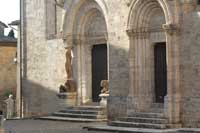
San Quirico d'Orcia
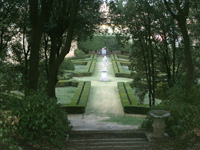
Horti Leonini in San Quirico d'Orcia
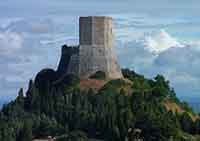
Rocca d'Orcia
|
|
|
|
|
|
|
|
|
|
|
|
|
|
South east of Pienza are Castelluccio di Pienza, a medieval castle, La Foce and Montichiello, a small centre in the heart of the Orcia valley whose beauty derives from its geographical position and the harmonious integration of its medieval architecture.
|
|
|
|
|
|
|
|
|
|
Monticchiello is a small centre in the heart of the Orcia valley whose beauty derives from its geographical position and the harmonious integration of its medieval architecture. Monticchiello still retains its old walls, towers and castle , the village inside the fortifications has maintained intact its medieval characteristics. Walking down the main street, there is the church of S. Agata. The 13th century Church of Santo Leonardo e Cristóforo, with a Gothic facade, contains an altar-piece of the Virgin and Child by Pietro Lorenzetti.
Special event is the il Teatro Povero, the Poor Theatre, a most impressive and clear sign of the town's vitality. Every year a new production, written, conceived and directed by the people of Monticchiello' returns to speak of past, present and future events of this community.
|
|
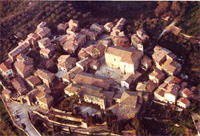
|
|
|
|
|
|
|
|
|
|
|
|
|
|
Montepulciano is in a near-idyllic location in the heart of the Tuscan countryside, between Pienza and Chiusi. The town centre ramparts encircle the historic heart of the town. The Renaissance-style palaces (Avignonesi, Communal, etc.) draw the eye along the streets surrounding the charming main square Piazza Grande.
The Corso, a long, winding street climbs up into the main square, which crowns the summit of the hill.
Montepulciano is chiefly known for its good local Vino Nobile wines.
Below the town, the Madonna di San Biaggio monument is a sight not to be missed. Built of honey - and cream - colored travertine, it is Sangallo's masterpiece.
The late Renaissance building was constructed on the site of a pre-existing Palaeochristian pieve dedicated to St. Mary and subsequently to St. Blaise. In the early 16th century only remains existed of the pieve, including a wall with a fresco of Madonna with Child and St. Francis, from a 14th century Sienese painter. The project was supported by Pope Leo X, who had studied under Angelo Poliziano, a native of Montepulciano.
The main façade, whose scheme is repeated (with some minor changes) on the two side ones, is divided into two sectors by a large entablature featuring a frieze with triglyphs and metopes which runs for the whole perimeter of the edifice. The lower sector houses the portal, on which is the foundation date. Above it is a window, in turn surmounted by a triangular pediment with, in the middle, a circular oculus. All the exterior is formed by travertine slabs.
The façade is flanked by the multifloor bell tower, with numerous decorative elements, which ends in a pyramidal cusp. The design included two symmetrical towers, but only one was built. |
|
|
|
|
|
|
|
|
|
|
|
|
|
|
|
Chianciano Terme stands on a hilltop overlooking to the west the Chiana valley, between Chiusi and Montepulciano. Chianciano Vecchia, as is called the ancient town of Chianciano, is very different from the modern quarter that has grown all around the Terme. It is situated on a hill and shows part of its medieval town walls and its medieval urban plan. The gate of the town is at the end of Via Dante, where stands Porta Rivellini with its elegant Renaissance structure.
Today, Chianciano Terme is considered among the finest health resorts in Europe.
Riserva Naturale Lucciola Bella
The Nature Riserve Riserva Naturale Lucciola Bella is situated south east of Pienza and Montichiello, in the Val d’Orcia, which stretches up to Chianciano Terme. The riserve is in a small corner of the typical landscape of the crete senesi. In fact the striking feature of the nature reserve is this unusual landscape of the calanchi and biancane, typical erosive features of the Crete Senesi landscape, mainly linked to grazing activities: they house important and exclusive vegetational and ornithological aspects.
|
|
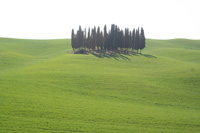
Cypresses in the Val d'Orcia |
|
|
|
|
|
|
|
La Foce is a vast family-owned estate in an idyllic rural setting.
Several walks cover the huge La Foce Estate brought to life so vividly by Anglo-American writer Iris Origo in her famous war diaries and includes a beech forest, pre-historic caves and an unforgettable view over the south Siena district. You visit the ancient village of Castiglioncello del Trinoro before returning to La Foce through oak woods. At the end of the walk there is an opportunity to visit the famous Italian style gardens created for Iris Origo by Cecil Pinsent at the villa of La Foce.
The property of La Foce lies on the hills overlooking the Val d'Orcia, a beautiful and miraculously intact valley in Southern Tuscany. The countryside abounds in lovely walks among woods and the characteristic crete senesi (clay hills); the food is among the best in Tuscany and famous wines such as vino Nobile and Brunello can be tasted in the local cellars.
Known as an important settlement from Etruscan times (a burial-place dating from the 7th century BC to the 2nd AD has been recently excavated on the property), La Foce has been continuously inhabited for many centuries. Later, its strategic position on the historical Via Francigena leading to Rome greatly increased its significance. The Villa itself was built in the late 15th century as a hostel for pilgrims and merchants traveling on this busy road. In 1924 the property was bought by Antonio and Iris Origo, who dedicated their lives to bringing prosperity and cultural and social changes to this poverty-ridden land.
Today the estate - a combination of woods, cultivated fields and olive groves - is run by the Origo daughters, Benedetta and Donata.
Address: Strada della Vittoria - Loc. La Foce | Villa La Foce
Giardini in Toscana | Villa La Foce
|
|
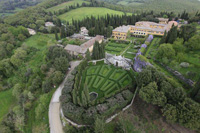
La Foce estate
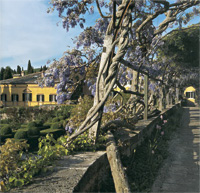
|
|
|
|
|
|
|
|
|
|
|
|
|
|
|
|
|
|
|
Surrounded by and overflowing a double ring of medieval city walls, Sarteano is a small hill in southern Tuscany on the ridge of Mount Cetona.
Sarteano is crowned with the ruins of a castle dating from around 1100. There are a number of ancient churches in the town, including the monumental complex of the ex-convent of Santa Chiara from the order of the Clarisse (1498).
The annual Giostra del Saracino takes place every August 15th.
To the southeast is found Mount Cetona, Radicofini, visible for miles around, its castle topping the solitary high plateau, the restored (privato) abbey of Spineto dating from 1016, Fonte Vetrianna, an isolated settlement with Etruscan and Medieval beginnings and the mineral springs of Bagno Santo.
|
|
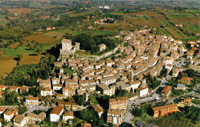
Sarteano
|
|
|
Chiusi, was one of the most powerful cities in the Etruscan league, reaching the 7th and 6th centuries BC. There is a large number of Etruscan tombs in the surrounding countryside. The
Museo Nazionale Etrusco is one of the most important repositories of Etruscan remains in Italy.
The Romanesque cathedral, the Duomo, is opposite the museum and built from recycled Roman pillars and capitals. The decorations on the nave walls appear to be mosaics, but in fact were painted by Arturo Viligiardi in 1887. There is an authentic Roman mosaic underneath the high altar.
The Museo della Cattedrale has a collection of codices and silverwares and leads into the Labyrinth of Porsenna, a series of tunnels beneath the town, dating from the sixth century BC and probably utilized in Etruscan-Roman times for drainage of rain waters.
|
|
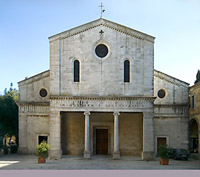
Chiusi
|
|
|
San Casciano dei Bagni is a tiny village near Siena, situated between the Paglia and Chiana valleys and surrounded by the Cetona, Amiata and Radicofani mountains.The origins of the village of San Casciano dei Bagni go back to the Etruscan and Roman Ages, when the first thermal baths were built.
Apart from the Terme, the most important monuments to see in San Casciano dei Bagni are the Chiesa Basilicale, the Collegiata di San Casciano and the Oratorio di Sant'Antonio.
Allerona, Palazzone, Fighine, Celle sul Rigo and Ponte a Rigo are in the surroundings of San Casciano dei Bagni.
|
|
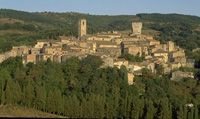
San Casciano dei Bagni
|
| Radicofani |
|
Radicofani is located in the natural park of Valdorcia andi borders the municipalitiesof Abbadia San Salvatore, Castiglione d'Orcia, Pienza, San Casciano dei Bagni and Sarteano.
The main landmark of Radicofani is its Rocca (Castle), of Carolingian origin and documented from 978. It was the castle of Ghino di Tacco. Occupying the highest point of a hill, at 896 m, it was restored after the conquest from the Grand Duchy of Tuscany (1560-1567). It has two line of walls: the external one has pentagonal shape, while the inner one is triangular, with three ruined towers at each corner and a cassero (donjon) which can be visited.
Also notable is the Romanesque church of San Pietro, with a nave, housing some works by Andrea della Robbia, Benedetto Buglioni and Santi Buglioni.
|
|
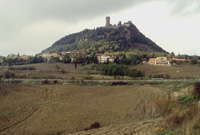
Radiciofani
|
| |
|
 |
| |
|
|
| |
|
| |
'We live on a large farm in southern Tuscany - twelve miles from the station and five from the nearest village. The country is wild and lonely: the climate harsh. Our house stands on a hillside, looking down over a wide and beautiful valley, beyond which rises Monte Amiata, wooded with chestnuts and beeches. Nearer by, on this side of the valley, lie slopes of cultivated land: wheat, olives and vines, but among them still stand some ridges of dust-coloured clay hillocks, the crete senesi - as bare and colourless as elephants' backs, as mountains of the moon. The wide river-bed in the valley holds a rushing stream in the rainy season, but during the summer a mere trickle, in a wide desert of stones. And then, when the wheat ripens and the alfalfa has been cut, the last patches of green disappear from the landscape. The whole valley becomes dust-coloured - a land without mercy, without shade. If you sit under an olive-tree you are not shaded; the leaves are like little flickering tongues of fire. At evening and morning the distant hills are misty and blue, but under one's feet the dry earth is hard. The cry of the cicadas shrills in the noonday.' [Iris Origo, War in Val d'Orcia' (1947), p.15-16 ]
|
|
| |
|
The Val di Chiana, Valdichiana, or Chiana Valley is an alluvial valley of central Italy, lying on the territories of the provinces of Arezzo and Siena in Tuscany and the provinces of Perugia and Terni in Umbria.
To the south-east, it reaches Lake Trasimeno and the valley of the Nestore River. To the west, it extends to the Val d'Orcia, where it reaches its highest altitude, 1,148 m (Monte Cetona).
|
|
|
| Acquapendente |
|
The area of modern Acquapendente was settled by Etruscans and Roman times, as findings have showed. The name of the city, meaning Pending Water, stems from the presence of several small waterfalls forming the Paglia, a stream setting the boundary between Lazio and Tuscany, although the border was set a few miles to the north of the river.
The most significant monument in Acquapendente is the Cathedral of San Sepolcro.
The tower of Julia di Jacopo, located near the church, marks the remains of the fortress built by Arrigo IV. The clock tower (also known as Barbarossa's tower) in the uppermost part of town was part of the imperial castle that was held by the Swabians for many years.
The Chiesa di San Francesco, built in 1149, houses many paintings and frescoes, a finely carved Gothic-style portal and inside an invaluable wooden crucifix of the 13th century.
The Pieve di Santa Vittoria with a wooden statue of the della Madonna del Fiore, made according to traditions form the chestnut tree of the miracle. Every third Sunday of May there is the Festa dei Pugnaloni to celebrate the Festa della Madonna del Fiore.
Porta S. Sepolcro, the entrance to the town from Rome, was located inside a tower which is the only remnant of the southern walls. In the XIIIth century Acquapendente expanded beyond the stream which came down the hillside. The walls built to protect the enlarged town were in part modified to upgrade them to the requirements of cannon warfare.
The Monte Rufeno Natural Reserve, 2 km north to the city, has secular woods housing wildlife including, among the others, boars, eagle owls, turtles and beech martens. It starts at an altitude of 200 meters above sea level (at the Paglia river) and goes up to an altitude of 700 meters (Mount Rufeno).
In January 1845 Charles Dickens travelled to Rome along Via Cassia. in Pictures from Italy he gave an account of his arrival in Acquapendente.
|
|
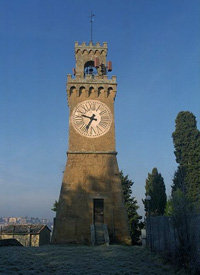 The clock tower, also known as
Barbarossa's tower |
| Città della Pieve |
|
Città della Pieve is a charming medieval town, located on the border between Tuscany and Lazio. Città della Pieve was the birthplace of the painter Pietro Vannucci known as “Il Perugino”. Several of his masterpieces are still present in the town, such as the famous Adoration of the Magi (1504) in the Oratory of Santa Maria dei Bianchi, the Madonna in Glory and Saints and the Baptism of Christ in the Duomo.
|
|
|
| Lake Trasimeno |
|
Lake Trasimeno or Lago Trasimeno, is the greatest of the central and southern Italy and the fourth of the whole country. With a surface of 128 square Km and circumference of 45 km, the Lake Trasimeno It has a tectonic origin, is made of laminar layers and is maximum depth if of above 9 meters.
The lake is fed by some streams, ditches and, canals realized at the end of nineteenth century in order to risolve the problem of the cyclic flooding The Lake Trasimeno is located in the communal territories of Castiglione del Lago, Magione, Panicale, Passignano sul Trasimeno and Tuoro sul Trasimeno.
Three islands rises from its waters: the Minore, the Maggiore and the Polvese, connected to the main coasts centre by the boats of the Servizio Provinciale di. Navigazione del Trasimeno. |
|
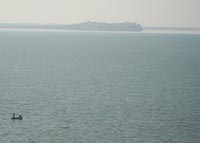
Lake Trasimeno or Lago Trasimeno |
|
|
|
|
|
|
|
|
|
|
|
|
|

Walking in Tuscany | Southern Tuscany | Montalcino, Pienza, Montepulciano, Villa La Foce and the Val d'Orcia
La Via Francigena | Da Ponte d'Arbia e Buonconvento a San Quirico d'Orcia
Abbey of Sant’Antimo website
Restaurants in Montalcino and Sant'Angelo in Colle
|
|
|
|
|
Enlarge map Val d'Orcia |
|
|
|
|
|
|
|
|
|
|
|
|
|

|
|
|
|
 |
|
| |
|
 |
|
|
|
 |
|
|
|
 |
|
|
|
 |
|
|

|
|
|
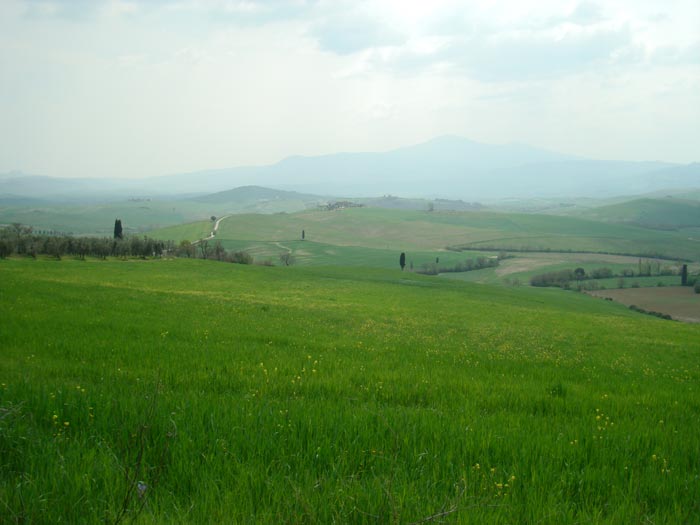 |
|
|
Stunning landscapes between Monticchiello and Pienza
|
| |
|


|
|
|
|
|
|
|
|
|
|
|
|
|
